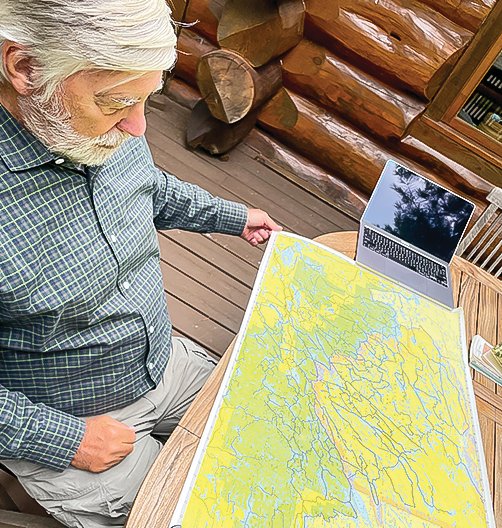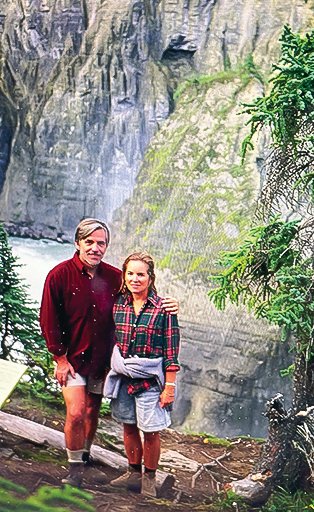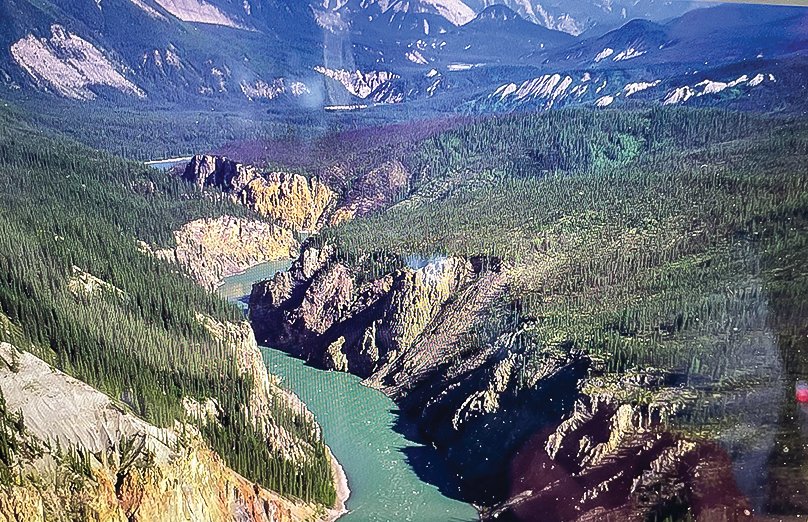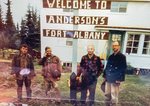Support the Timberjay by making a donation.
Adventure’s in his DNA
For Bill Rom, the canoe country launched a lifetime of explorations in the north
REGIONAL— Bill Rom was sporting a bushy gray beard recently when we sat down to talk on the deck of his Burntside Lake summer residence. It was a sign that his sense of adventure had gotten the …
This item is available in full to subscribers.
Attention subscribers
To continue reading, you will need to either log in to your subscriber account, or purchase a new subscription.
If you are a current print subscriber, you can set up a free website account and connect your subscription to it by clicking here.
If you are a digital subscriber with an active, online-only subscription then you already have an account here. Just reset your password if you've not yet logged in to your account on this new site.
Otherwise, click here to view your options for subscribing.
Please log in to continue |
Adventure’s in his DNA
For Bill Rom, the canoe country launched a lifetime of explorations in the north
REGIONAL— Bill Rom was sporting a bushy gray beard recently when we sat down to talk on the deck of his Burntside Lake summer residence. It was a sign that his sense of adventure had gotten the best of him yet again.
Rom, now in his late 70s, had just returned from a weeks-long journey down the Winisk River in northern Ontario, a huge wilderness river that Rom acknowledges was probably the most dangerous he’d ever visited in his 70-plus years of travel by canoe. Just as our own North Country experienced record high water earlier this year, the vast and remote Winisk River was exceptionally high and dangerous, with almost continuous rapids for hundreds of miles, clouds of mosquitoes, and little hope of rescue had Rom and his small party of fellow adventurers run into trouble.
In other words, it was right up Rom’s alley— a journey deep into the wilderness, requiring skill, experience, and a certain obsession with the unknown.
It’s an obsession honed beginning as a child growing up in Ely, the son of a successful canoe outfitter. Rom was born in 1945 in San Francisco, to Bill Rom Sr., who had just been discharged after his service in the Navy in World War II. Bill Sr. had grown up in Ely and was eager to return to his hometown at the end of the road, where he used a GI loan to found Canoe Country Outfitters, the business that soon introduced Rom and his siblings, including his sister Becky, to life in a canoe.
For the young Rom, exploring the canoe country was a passion he has yet to outgrow. While, in his earliest years, he helped out at the outfitting shop, at the ripe old age of 14 he became a wilderness guide, apprenticing under the likes of Jeep LaTourell and Fred McReady.
When he wasn’t working in the wilderness, he was exploring it.
“When I had free time, I talked my friends into long trips, usually the kind with 30 or 40 portages,” recalls Rom. He was always up for a challenge, the tougher the better. Back in the 1960s, he regularly took part in the International Canoe Derby, a race from Atikokan to Ely and back again, which totaled 200 miles there and back along with 52 portages. The annual event, which was sponsored in part by Canoe Country Outfitters, only survived a few years as Rom noted the organizers had trouble finding competitors willing to subject themselves to the abuse.
Through his years exploring the canoe country, he figures he’s been to 90-95 percent of the roughly 1,100 lakes found on the American side alone. He still regularly ventures to those few Boundary Waters lakes he’s yet to visit, and most of those trips involve a considerable amount of bushwhacking. “A lot of the smaller lakes have no developed portages,” he notes. At first, Rom was motivated by curiosity. “But once you’ve gotten to so many lakes, you begin to think you should just get to them all,” he said.
Earlier this summer, he made the trip to Sinneeq Lake, located in the northwestern part of the Boundary Waters, off of Wagosh Lake. Among other things, the journey required a three-quarter mile bushwhack from Wagosh. To call it difficult is an understatement, but there are sometimes rewards along the way. “We ran into some incredible old growth,” he said.
Rom’s fascination for the canoe country extends well beyond its headwaters in the Quetico-Superior. “When you grow up in Ely, on the Voyageurs Highway, your dream is naturally to go to Fort Chipewyan, which was at the far end of the trail on Lake Athabasca,” he said. Further inspired by Sigurd Olson’s third book, “The Lonely Land,” published in 1961, Rom was soon making plans for his first of many trips into northern Canada. In 1965, he spent weeks portaging and canoeing hundreds of miles through the northern Ontario bush, then finally down the enormous Albany River, which eventually empties into James Bay. Rom provides his most detailed account of the trip in his first book, “Canoe Country Wilderness,” published in 1987 by Voyageur Press.
In 1967, Rom canoed for 40 days and over 1,500 miles down a portion of the Peace River in northern Alberta, later connecting with the Churchill River, which extends all the way to Hudson Bay.
Rom began medical school later that year and his studies put a temporary crimp on his adventuring. Even so, every summer he made a point of returning to Ely for at least one trip into the wilderness. On one of those trips he was accompanied by his future wife, Holly, for whom the Boundary Waters was a kind of proving ground. “Of course, we had to do a canoe trip,” said Rom. “It was ten days and she caught the biggest lake trout, so that was that.”
According to Bill, the two first met when he was jogging near the Harvard campus during his medical school days and he spotted her across the river. He took the next bridge and crossed to catch up with her and introduced himself.
By the late 1970s, after completing his degree at Harvard and accepting a fellowship at Mt. Sinai Medical Center in New York City, Rom made time for another adventure, a weeks-long trip on the Back River, in what is now Nunavit, with a friend and serious mountain climber he’d met in medical school. They journeyed first to Yellowknife on Great Slave Lake, where they chartered a flight north to the Back River, which flows to the Arctic Ocean. It was, indeed, a lonely land, as Rom discovered even as their ride was departing. “Up there, just seeing the plane take off is when your stomach drops,” he said. This was barren ground, which did make the portaging somewhat easier, Rom said. It was late July and snowbanks still lined the river in places. In their 300 miles of paddling, they saw no other signs of humans, other than a few rock cairns, Roms recalls, although they did see plenty of musk oxen.
In 1992, Rom and Holly ventured with a small group down the famed Nahanni River in the Northwest Territories. The Nahanni goes through some of the most dramatic geology in all of Canada, including a portion of the river known as “Canada’s Grand Canyon.” The journey down the enormous river started just downstream of Virginia Falls, a massive cataract approximately 300 feet high, or nearly twice the height of Niagara Falls.
For Rom, exploration is part of his DNA, and his social set. He’s a member of the New York City-based Explorer’s Club, an elite group of hardcore explorers whose adventures are expected to contribute in some way to a scientific understanding of the remote places they visit. Members earn flags for journeys of significance and Rom just earned his fifth flag for his trip down the Winisk. He’s earned other flags for such things as taking part in a spring hunt with Inuit in Greenland—a trip he joined with Paul Schurke— as well as for a ski and crampon trek across glacier-covered South Georgia Island, a trip he undertook with Holly and his youngest daughter, led by five guides seasoned on Mt. Everest. He was also among the first westerners to ever visit a remote mountain in Tibet that’s the ultimate source of the Yangtze River. He, along with his mountain climbing friend from medical school, also managed to summit the previously unclimbed Mt. Doonerak, a 7,400-foot peak in the Brooks Range in northern Alaska.
Rom has been equally high achieving in his medical career, where his clinical research on cytokines, an area of study he shared with his colleague Tony Fauci, has broken new ground.
He also studied lung scarring in asbestos workers and coal miners and along the way founded the Rocky Mt. Center for Occupational and Environmental Health in Salt Lake City, an institution that still exists today. Later, he went to the National Institute of Health in Bethesda, Maryland, before moving on to a 25-year stint at Bellevue Hospital in New York City. At age 70, he stepped down from that position to take up a new job at the NYU School of Global Public Health, where he teaches graduate students about climate change and undergraduates about environmental health. He’s written a number of books over the years, including several on his medical studies.
Though his work and travels take him around the world, Rom finds his grounding each summer when he returns to the pine-studded family property on Burntside, where he maintains a log cabin, a guest house and an art studio for Holly above the garage. His father bought the point on Burntside’s north side in the 1940s and it’s been in the family ever since. From here, Rom and others can sit at the southern edge of the Quetico-Superior and at the very head of a vast watershed that is an integral part of that lonely land to the north that still beckons him even as he nears his 80s. Here, in his one true home, he can pore over his maps and plan his next adventure.















